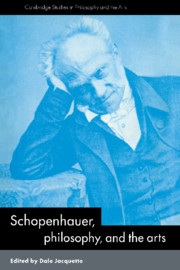Book contents
- Frontmatter
- Contents
- List of contributors
- Editor's acknowledgments
- List of abbreviations
- 1 Schopenhauer's metaphysics of appearance and Will in the philosophy of art
- PART I The work of art: Schopenhauer on the nature of artistic creation
- PART II The experience of beauty: Schopenhauer's theory of aesthetic encounter
- PART III Schopenhauer's enduring influence on the arts: idealism and romanticism
- 9 Schopenhauer on music as the embodiment of Will
- 10 Schopenhauer and the musicians: an inquiry into the sounds of silence and the limits of philosophizing about music
- 11 Metaphysics and aesthetics: a case study of Schopenhauer and Thomas Hardy
- 12 Schopenhauer according to the Symbolists: the philosophical roots of late nineteenth-century French aesthetic theory
- 13 Schopenhauer's philosophy of architecture
- Bibliography of selected sources on Schopenhauer's aesthetics
- Index
12 - Schopenhauer according to the Symbolists: the philosophical roots of late nineteenth-century French aesthetic theory
Published online by Cambridge University Press: 05 May 2010
- Frontmatter
- Contents
- List of contributors
- Editor's acknowledgments
- List of abbreviations
- 1 Schopenhauer's metaphysics of appearance and Will in the philosophy of art
- PART I The work of art: Schopenhauer on the nature of artistic creation
- PART II The experience of beauty: Schopenhauer's theory of aesthetic encounter
- PART III Schopenhauer's enduring influence on the arts: idealism and romanticism
- 9 Schopenhauer on music as the embodiment of Will
- 10 Schopenhauer and the musicians: an inquiry into the sounds of silence and the limits of philosophizing about music
- 11 Metaphysics and aesthetics: a case study of Schopenhauer and Thomas Hardy
- 12 Schopenhauer according to the Symbolists: the philosophical roots of late nineteenth-century French aesthetic theory
- 13 Schopenhauer's philosophy of architecture
- Bibliography of selected sources on Schopenhauer's aesthetics
- Index
Summary
The future belongs to Decadism. Born of the world-weariness of a Schopenhauerian civilization, the Decadents' … mission … [is] to … demolish the old order and prepare the embryonic elements of the great national literature of the twentieth century.
Le Decadent, 1890INTRODUCTION
Almost all the painters, writers and critics of the late nineteenth century in France frequently mentioned the influence of Schopenhauer on their ideas. Every literary critic and art historian writing on the period today associates the Symbolists with Schopenhauer. Yet it is difficult to assess exactly – since no hard evidence is ever offered by either group – to what extent they read him, what they read of his work, and, in any detail, which ideas they borrowed. Schopenhauer's The World as Will and Representation, was, when it appeared in 1818 (publication date 1819), hardly read in France but became the rage among Symbolists and Decadents in the eighties and nineties after the translation of his work by among others, Theodule Ribot in his 1874 commentary La Philosophie de Schopenhauer, and by a later edition of fragments translated by Jean Bourdeau which came out in 1880 entitled Pensées, Maximes et Fragments, as well as a second edition of Ribot's work in 1885. In 1888, given the work's popularity, WWR was again translated into French.
- Type
- Chapter
- Information
- Schopenhauer, Philosophy and the Arts , pp. 249 - 276Publisher: Cambridge University PressPrint publication year: 1996
- 3
- Cited by



